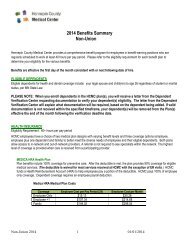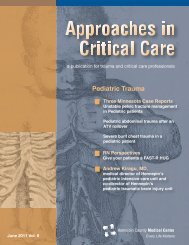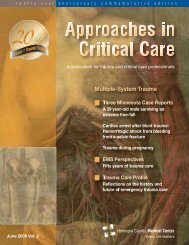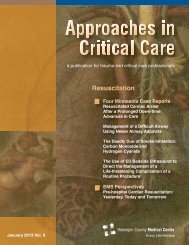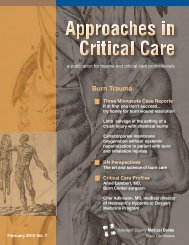Ischemic Stroke - Hennepin County Medical Center
Ischemic Stroke - Hennepin County Medical Center
Ischemic Stroke - Hennepin County Medical Center
Create successful ePaper yourself
Turn your PDF publications into a flip-book with our unique Google optimized e-Paper software.
EMS Perspectives<br />
“ Refinements<br />
in treatment<br />
have<br />
increased the<br />
window of<br />
treatment<br />
time from a<br />
mere 3 hours<br />
from<br />
symptom<br />
onset to<br />
6-12 hours<br />
from<br />
symptom<br />
onset,<br />
depending on<br />
the location<br />
of the insult.”<br />
Assessment and prehospital<br />
management*<br />
Like trauma and STEMI patients, the<br />
patient with stroke symptoms needs<br />
definitive care. While the assessment<br />
must be thorough, one must weigh<br />
the benefit of any procedure performed<br />
at the scene with the risk of<br />
delaying transport. Many procedures,<br />
such as IV access, usually can be<br />
performed en route to the hospital.<br />
Airway. Neurologic impairment of the<br />
face and mouth may require airway<br />
assistance. Depending on the<br />
patient’s level of consciousness, this<br />
may be as simple as positioning and<br />
suctioning secretions as needed.<br />
Adjuncts for airway management<br />
should be used as necessary but with<br />
caution, as the placement of some<br />
devices (most notably endotracheal<br />
intubation) may result in increased<br />
intracranial pressure.<br />
Breathing. Ventilatory support should<br />
be provided as necessary. For the<br />
breathing patient, oxygen should be<br />
provided. The use of high amounts of<br />
oxygen in the non-hypoxic patient is<br />
currently under study and is controversial.<br />
The American Heart<br />
Association currently recommends<br />
supplemental oxygen to allow a SpO2<br />
of >92%. This is a significant departure<br />
from many EMS practices that<br />
aim for 100% O2 saturation.<br />
Circulation. In most cases, the<br />
patient with stroke requires little<br />
actual circulatory support. Advanced<br />
life support (ALS) providers should<br />
establish IV access using 0.9%<br />
saline. D5W should be avoided in the<br />
patient with stroke. Transport should<br />
not be delayed for IV access. IV fluid<br />
administration should be limited to<br />
KVO or a saline lock should be<br />
placed. Avoid multiple IV attempts, as<br />
they will result in increased bleeding<br />
during treatment.<br />
What about hypertension? Many<br />
EMS agencies “treat” acute hypertension<br />
in the field. This is not recommended<br />
in the case of acute<br />
ischemic stroke. In the ischemic<br />
stroke patient, hypertension may be<br />
providing additional perfusion to the<br />
ischemic portion of the brain.<br />
Reducing systemic blood pressure<br />
can worsen the stroke in a subset of<br />
patients. Some treatment protocols in<br />
the emergency department include<br />
increasing the blood pressure slightly<br />
in some patients and avoiding reduction<br />
of blood pressure unless the systolic<br />
BP is >220 mmHg and the diastolic<br />
BP is >110 mmHg. The risks of<br />
lowering blood pressure in the field<br />
are higher than any potential benefit.<br />
Also, aspirin is not a safe medication<br />
to give during acute stroke without<br />
first confirming by CT that the stroke<br />
is ischemic and not hemorrhagic.<br />
Glucose level. Acute hypoglycemia<br />
can mimic acute stroke. When<br />
possible, a glucose level should be<br />
checked during the initial examination<br />
of the patient. Hypoglycemia should<br />
be corrected immediately.<br />
Neurological assessment. In addition<br />
to level of consciousness and<br />
orientation, EMS providers should<br />
assess the patient’s stroke symptoms<br />
using the Cincinnati <strong>Stroke</strong> Scale.<br />
(See Figure One.)<br />
Electrocardiogram. An initial ECG<br />
should be obtained when possible.<br />
Twelve-lead ECGs should be<br />
assessed for ischemic changes.<br />
Approaches in Critical Care | December 2008 | 15





